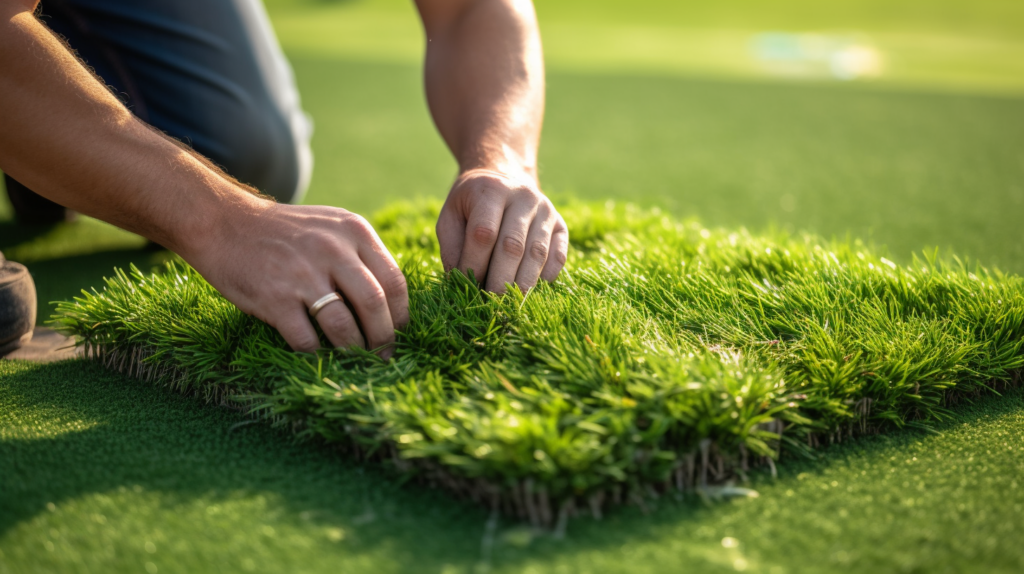Last Updated on October 31, 2023
Building a golf green isn’t as hard as it looks; all it takes is some know-how and determination. Choose the type of grass seed best suited for your climate and soil conditions. When planting your lawn, make sure that you take into account drainage patterns, so water doesn’t pool in certain areas and cause damage over time. After giving for your grass to become established, it’s time to shape up your golf green by mowing on a regular basis according to recommended guidelines.
Finally, once you’ve achieved the desired shape and grade of the green itself, it’s time to install any additional features like bunkers or hazards. Keep in mind that these types of additions are entirely optional – they won’t affect playability but can provide visual interest if done correctly.
Materials Needed
Building a golf green can be an arduous task, but with the right materials and tools, it’s definitely achievable. Firstly, you’ll need sand for your golf green as well as turf that is specially designed for use on putting greens. Furthermore, you’ll want to make sure you have all of the necessary construction tools, such as shovels and rakes. Netting should also be used in order to protect your golf green from any damage by animals or pests. Lastly, ensure you get yourself a liner which will help keep moisture away from your green so that it doesn’t become waterlogged over time. With these items ready at hand, you’re now set to begin constructing your very own golf green.
Layout and Design
Once you’ve decided on the size and shape of your golf green, it’s time to plan its design. The layout should follow a typical green style with nine or eighteen holes. You’ll want to make sure there is enough space between each hole for players to move around comfortably. Turf layout is also important when designing a golf green – different types of grass can be used depending on what type of play you’re looking for. When planning the hole design, consider adding obstacles such as bunkers, sand traps, and water hazards that will add challenge and difficulty for experienced players. As an added touch, incorporating trees as part of your overall design further enhances the aesthetic appeal of the course. With careful consideration given to these factors during the planning stages, you can ensure that your golf green meets all expectations in terms of functionality and visual impact.
Soil Preparation
Proper soil preparation is one of the most important steps when building a golf green. Before you begin, it’s essential to assess the quality and fertility of your soil with a comprehensive soil test. After all, this will determine which amendments and fertilisers are required for optimal growth. Here are some key tips:
- Perform regular soil testing to monitor nutrient levels and pH balance.
- Amend soils as needed by adding organic material or fertiliser specific to turfgrass type.
- Aerate regularly to improve water infiltration, root development, and overall health of the grass.
These efforts will help ensure that your greens have proper drainage and remain healthy over time, allowing them to withstand daily wear and tear from foot traffic. With consistent care, you’ll be able to create an exceptional playing surface year after year.
Turf Installation
The first step in constructing a putting green is turf installation. The most important part of this process is selecting the right grass for the project. You must take into consideration factors such as local climate, soil type, and budget when deciding on turfgrass. Once you have determined which grass will work best, it’s time to prepare the site for installation. This includes removing existing vegetation, grading or amending the soil, and installing an irrigation system if needed. Be sure to select sod that has been harvested within two weeks prior to installation for optimal quality. After laying down the turf and rolling it with a heavy roller, the next step is to cut out any tee boxes or fairway grass areas that may be included in your design plan. Finally, make sure you keep up with regular maintenance tasks like mowing and fertilising your new putting green to ensure its health and longevity for years to come.
Drainage System
A key component of building a successful golf green is a well-designed and maintained drainage system. It’s essential for controlling water levels on the course so that your greens remain playable in any weather conditions. As such, careful attention needs to be paid when designing and installing the drainage system, as well as during ongoing maintenance. The design should take into account soil type and topography, precipitation rates, and other local factors. During installation, it’s important to ensure proper placement and connection of pipes, catch basins, outlets, etc., while being mindful of existing vegetation or trees in the area which need to be preserved.
Once installed, regular inspections are necessary to check for clogs or blockages that can cause localised flooding or ponding. Troubleshooting these issues quickly is vital; if left unchecked, they could lead to costly repairs down the road. Regular maintenance also includes inspecting pumps and valves for functionality, ensuring piping remains clear throughout its length, checking irrigation systems are working properly with no leaks present and making sure all parts of the drainage system are functioning together correctly. Keeping up with this kind of preventative maintenance helps keep repair costs low over time – something every golf club strives for.
Irrigation System
Moving on from the drainage system, it’s time to discuss irrigation systems. The table below provides key information about sprinkler system installation:
| Irrigation System Design | Sprinkler System Installation | Watering Frequency and Scheduling | |
|---|---|---|---|
| A | Automated Controllers | Rain Sensors | Daily/Weekly |
| B | Pressure Regulators | Rotary Heads | Seasonal |
| C | Soil Moisture Monitors | Multi-stream Nozzles | Event-Based |
To make sure that water conservation methods are put into place, automated controllers can be used to regulate the pressure levels of the sprinklers, and soil moisture monitors can be implemented to assess when watering is necessary. By using rain sensors on each hole, we can reduce the amount of manual labour needed to manage our watering frequency and scheduling – making our jobs as superintendents much easier. It is important that seasonal changes such as temperature, humidity, precipitation amounts and wind speeds are taken into account when setting up the irrigation schedule so that optimal water usage occurs while still providing enough water for great playing conditions throughout the year. Additionally, event-based scheduling should also be considered if tournaments or other events will require certain areas of the green to be prepared differently than normal days. With all these factors in mind, your golf course will have beautiful greens all season long.
Soil Testing and Fertilisation

Soil testing is an important step in building a golf green. Professional soil testing can help identify any deficiencies or imbalances in the soil and provide fertiliser recommendations for optimal turfgrass health. The results of this test will determine which fertilisation methods should be used to replenish essential nutrients in the soil. When applying fertiliser, it’s important to follow all directions on product labels and use quality products designed specifically for golf courses.
When selecting a fertiliser, consider the type of grass being grown as well as its current nutrient requirements. A professional can also make detailed recommendations about how much fertiliser should be applied based on the latest research findings. In addition, they may suggest certain techniques to optimise application efficiency and reduce costs associated with over-fertilising. After implementing these strategies, regular monitoring is necessary to ensure that nutrients are maintained at healthy levels throughout the growing season.
Mowing and Maintenance
Mowing is a critical component in creating and maintaining an inviting playing surface. The frequency of mowing should be based on the type of turf being cut; this could range from twice per week to once every two weeks, depending on the conditions. It’s important to select an appropriate mower for each area that is suited to the job at hand, whether it’s rough or green cutting. Turf care also includes weed control, aerating greens and other areas as needed, topdressing fairways and tees, fertilising, irrigation management and more. All these tasks are necessary to produce healthy-looking grass with good colour throughout the season. Lastly, focusing on drainage issues can help prevent diseases caused by poor air circulation due to excessive moisture build-up around plants. A proactive approach to any potential problems is best practice when working towards producing quality golf surfaces. Keeping up with regular maintenance will ensure your course looks its best all year long.
Frequently Asked Questions
What Type of Grass Is Best For a Golf Green?
When talking about golf greens, one of the most important elements is grass. Finding the right type of turfgrass to use on a golf green can be challenging because there are so many types available. It’s important to take into account factors such as climate, soil and budget when deciding which turf grass varieties are best suited for your particular golf course.
You can choose from various turf grass types for your golf green, such as bentgrasses, perennial ryegrass, annual bluegrass, and fescue. Bentgrasses are typically used in warmer climates; they’re known for their ability to stay greener throughout the year but require frequent mowing and maintenance due to their shallow root system. Perennial ryegrasses provide an excellent winter playing surface and generally have good wear tolerance compared to other cool-season grasses; however, they may not be suitable for hot summer temperatures or wet soils. Annual bluegrass germinates quickly and provides a nice colour during cooler times of the year; however, this type of grass requires more maintenance than some others due to its low heat tolerance and tendency towards disease problems. Lastly, fescues tend to perform well in both dry weather conditions as well as moist ones; this makes them ideal for areas with varying levels of moisture throughout the year.
In order to determine which type of lawn would be best suited for your golf green, consider all these factors before making a decision – from climate/soil conditions and budget restrictions to desired characteristics such as leaf texture or resistance against pests/diseases. Careful consideration today will ensure you get the perfect turfgrass for years to come.
How Do I Protect the Green From Pests and Disease?
Protecting a golf green from pests and disease is an important part of keeping it in top condition. The most effective way to protect a golf green is through preventative measures, such as proper maintenance and upkeep. Pest control for the golf green should involve using insecticides or other pest management techniques that are tailored to the region and soil type. Disease control on the green also requires preventive measures like aeration, soil testing, and fungicide treatments.
Additionally, creating barriers between turf grasses and surrounding areas can help reduce infestation risks. This could include installing fencing around the perimeter or introducing natural predators into the environment. Another key component of protection is monitoring for signs of infection or damage caused by pests or diseases. Regular observation will allow you to catch problems early before they become severe; this means less disruption to play during treatment.
Golf course superintendents must be vigilant in their efforts to keep greens free from pests and disease in order to maintain optimal conditions for playing surfaces year-round. With careful planning and execution, your golf green will stay healthy and look great.
How Often Should I Water the Green?
Maintaining a golf green’s health and condition is largely dependent on the irrigation schedule. The watering frequency, amount of water used for irrigation, and other components of green maintenance are all important to consider when creating an optimal irrigation schedule.
To maintain your golf green to its fullest potential, here are five tips for creating an effective watering frequency:
- Monitor the weather conditions – Watering should be adjusted depending on how much precipitation has fallen in order to prevent overwatering or underwatering.
- Consider soil type – Depending on the type of soil present at the course, different amounts of water will be needed.
- Adjust according to the season – Different levels of water usage will be required during warmer months compared to cooler ones due to higher rates of evaporation from increased temperatures.
- Track temperature changes – Heavier applications may be necessary following extreme heat waves that could damage turfgrass if left underwater for too long periods of time.
- Assess plant stress – If plants become stressed from lack or overabundance of water, this can cause many issues, such as disease or pest control problems, which can lead to further maintenance concerns down the line.
It’s essential that you have an efficient plan for golf green irrigation scheduled throughout the year that fits with local climate patterns and reflects current weather trends each week so that your greens remain healthy and well-maintained all season long.
Conclusion
In conclusion, building a golf green is no easy task. It takes careful planning and knowledge to get the job done right.
By following these guidelines, you’ll have a beautiful golf green that will provide players with many years of great playtime memories. With proper care and maintenance, there’s no reason why your green won’t last for decades and give countless visitors plenty of enjoyment out on the fairways.


